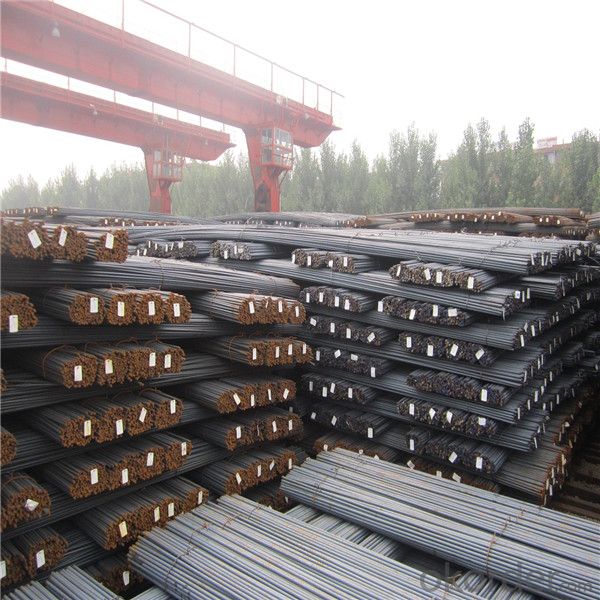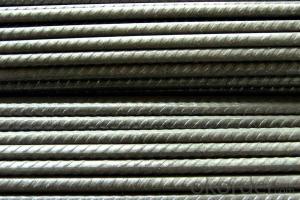Hot rolled Reinforcing Steel rebar 6-12m
- Loading Port:
- China main port
- Payment Terms:
- TT OR LC
- Min Order Qty:
- 1000 m.t.
- Supply Capability:
- 17497 m.t./month
OKorder Service Pledge
OKorder Financial Service
You Might Also Like
Specification
Rebar has ridges that bind it mechanically to the concrete with friction, it can still be pulled out of the concrete
under high stresses, an occurrence that often precedes a larger-scale collapse of the structure. To prevent such
a failure, rebar is either deeply embedded into adjacent structural members, or bent and hooked at the ends to lock
it around the concrete and other rebars. This first approach increases the friction locking the bar into place while the
second makes use of the high compressive strength of concrete.
Product Description :
Chemical composition (%): | Steel | C | Si | Mn | P | S | Ceq | ||||
HRB335 |
0.25 |
0.80 |
1.60 |
0.045 |
0.045 | 0.52 | |||||
HRB400 | 0.54 | ||||||||||
HRB500 | 0.55 | ||||||||||
Mechanical properties | Steel | Rel/ MPa | Rm/ MPa | A/ % | Agt/ % | ||||||
≥ | |||||||||||
HRB335 | 335 | 455 | 17 |
7.5 | |||||||
HRB400 | 400 | 540 | 16 | ||||||||
HRB500 | 500 | 630 | 15 | ||||||||
Package: | Standard export packing or as customer's request | ||||||||||
Application: | Construction, building, bridge, road. ect | ||||||||||
Payment terms | 1).100% irrevocable L/C at sight. | ||||||||||
Delivery time | 15-30 days after receipt of L/C or deposit by T/T | ||||||||||


Features
1、Pure steel quality, stable chemical contents, small tolerance.
2、Constant Quality, good drawing performance.
3、High dimension accuracy degree, accuracy degree of Level C up to 80%, smooth surface, less scale, easy to be pickled.
4、Automatic bundling with 4 lines by Machine in tidy and good looks
5、Big high quality percentage, small coil percentage, and heavy coil weight for Hard Coil.
6、High sorbitizing percentage.
Packing:
In bundles, each bundle weight 3.5 tons. Load by container or by bulk verssel.


FAQ:
1.Q: What's your MOQ(minimum order quantity)?
A: One full container, mixed acceptable .
2. Q: What's your packing methods?
A: Packed in bundle or bulk ..
3. Q: How can I buy CNBM products in my country?
A:Please send us an inquiry or email ,we will reply to you if there is distributor in your country
4. Q: Can we visit your factory?
A: Warmly welcome. Once we have your schedule, we will arrange the professional sales team to follow up your case.
5. Q: How long does it take to get the product if i place an order?
A:With the process of your requirements,we will pack and deliver in 3-7 days. If it is by sea shipment,it will take 15-45 days depending on different locations
- Q: How are steel rebars bent or shaped according to construction needs?
- Steel rebars are bent or shaped according to construction needs through a process called rebar bending. This is typically done using specialized machinery, such as rebar benders or bar bending machines. The rebars are placed in the machine, and hydraulic or mechanical force is applied to bend them into the desired shape or angle. The bending process ensures that the rebars fit perfectly into the designated areas of the construction project, providing structural support and reinforcing concrete structures.
- Q: What is the effect of aging on the properties of steel rebars?
- The effect of aging on the properties of steel rebars is generally negative. Over time, steel rebars may experience gradual deterioration due to factors such as corrosion, fatigue, and stress. This can lead to a reduction in their structural integrity and load-bearing capacity. Aging can also cause an increase in brittleness, making rebars more prone to fractures and failures. Therefore, regular inspections, maintenance, and potentially replacement of aged rebars are crucial to ensure the safety and longevity of structures.
- Q: How are steel rebars protected from vandalism during construction?
- Steel rebars are generally protected from vandalism during construction through various measures such as fencing off the construction site, employing security personnel, installing surveillance cameras, and implementing access control systems. Additionally, some construction sites also use anti-vandal coatings or cover the rebars with concrete to make them less accessible and susceptible to damage.
- Q: Can steel rebars be used in underground parking garage construction?
- Yes, steel rebars can be used in underground parking garage construction. Steel rebars are commonly used in the construction of reinforced concrete structures, including underground parking garages. The rebars provide strength and reinforcement to the concrete, making it capable of withstanding the weight and pressure of the structure above. In addition, steel rebars offer excellent resistance to corrosion, which is especially important in underground environments where moisture and other corrosive elements may be present. Overall, steel rebars are a reliable and commonly used choice for reinforcing concrete in underground parking garage construction.
- Q: What is the purpose of stirrups in steel rebar reinforcement?
- Stirrups in steel rebar reinforcement serve to offer lateral support and improve the overall structural integrity of reinforced concrete components. Typically made of bent steel bars, stirrups are positioned around the longitudinal rebar within concrete columns, beams, or slabs. One of the primary functions of stirrups is to prevent buckling or bending of the longitudinal rebar caused by external forces like compression, tension, or shear. By enclosing the rebar with closely spaced stirrups, the strength and stability of the reinforced concrete element are significantly increased. Additionally, stirrups play a crucial role in resisting shear forces, which arise when a structure is subjected to lateral loads or earthquakes. These forces can lead to cracking and failure of the concrete. However, stirrups distribute shear stresses more evenly, effectively impeding the formation and propagation of cracks. Moreover, stirrups enhance the bond between the rebar and concrete by providing extra contact area. This, in turn, results in improved load transfer and prevents slippage between the rebar and the surrounding concrete. To summarize, stirrups in steel rebar reinforcement aim to enhance the structural strength, stability, and durability of reinforced concrete elements. They offer lateral support, resist bending and shear forces, and enhance the bond between the rebar and concrete. By incorporating stirrups into the reinforcement design, engineers can ensure that the concrete structure can withstand various external loads and maintain its integrity over time.
- Q: How do steel rebars affect the overall strength of a structure?
- Steel rebars significantly enhance the overall strength of a structure by providing reinforcement and increasing its tensile strength. They act as a skeleton within the concrete, distributing the load more evenly and preventing cracks or failures.
- Q: Are steel rebars resistant to earthquakes?
- Yes, steel rebars are highly resistant to earthquakes. The use of steel reinforcement in concrete structures helps to improve their structural integrity and ability to withstand seismic forces. Steel rebars enhance the strength and flexibility of the concrete, making it more capable of absorbing and dissipating the energy generated during an earthquake.
- Q: What is the standard length of steel rebars?
- The length of steel rebars commonly differs according to the region and project specifications. In the United States, for instance, the standard length is typically 20 feet or 6.1 meters. Nevertheless, it is crucial to acknowledge that rebars can be tailored and adjusted to meet the required lengths for a specific construction project. Moreover, in certain countries or regions, rebars may come in various standard lengths as per local construction norms and regulations. Hence, it is imperative to refer to local codes and specifications for determining the appropriate standard length of steel rebars for a particular project.
- Q: How are steel rebars transported and stored on construction sites?
- Trucks or trailers are typically used to transport steel rebars to construction sites. These vehicles are specifically designed to safely carry and unload the heavy and bulky rebars. When the rebars arrive at the site, they are usually offloaded using cranes or forklifts. To make storage and access more efficient, rebars are often kept in designated areas known as rebar yards. These yards are typically organized in a manner that allows for easy identification and retrieval of rebars when needed. The rebars are sorted and stacked according to their size, length, and type to avoid any confusion during construction. In the rebar yard, rebars are commonly stored horizontally on racks made of steel or wood. These racks are designed to provide proper support and prevent any damage to the rebars. It's important to note that rebars should be stored above ground level to protect them from moisture, rust, and contamination. They should also be kept away from damp areas and direct contact with soil. To maintain the quality of the rebars, it's crucial to protect them from rain, snow, and excessive sunlight. Therefore, construction sites often utilize protective covers like tarps or plastic sheets to shield the rebars and prevent any corrosion or deterioration. Additionally, construction workers must handle rebars with care to avoid bending or deformation. Special attention should be paid to prevent dropping or dragging of rebars, as it can compromise their structural integrity. Overall, careful planning and adherence to safety guidelines are necessary for the transportation and storage of steel rebars on construction sites. This ensures the rebars maintain their quality and effectiveness in reinforcing concrete structures.
- Q: What is the role of steel rebars in the construction of railway bridges?
- The role of steel rebars in the construction of railway bridges is to provide reinforcement and strength to the concrete structure. Rebars are embedded within the concrete to enhance its tensile strength, allowing the bridge to withstand heavy loads, vibrations, and environmental factors such as temperature changes. This reinforcement ensures the structural integrity and longevity of the railway bridge, making it safe and durable for train traffic.
Send your message to us
Hot rolled Reinforcing Steel rebar 6-12m
- Loading Port:
- China main port
- Payment Terms:
- TT OR LC
- Min Order Qty:
- 1000 m.t.
- Supply Capability:
- 17497 m.t./month
OKorder Service Pledge
OKorder Financial Service
Similar products
Hot products
Hot Searches
Related keywords


























